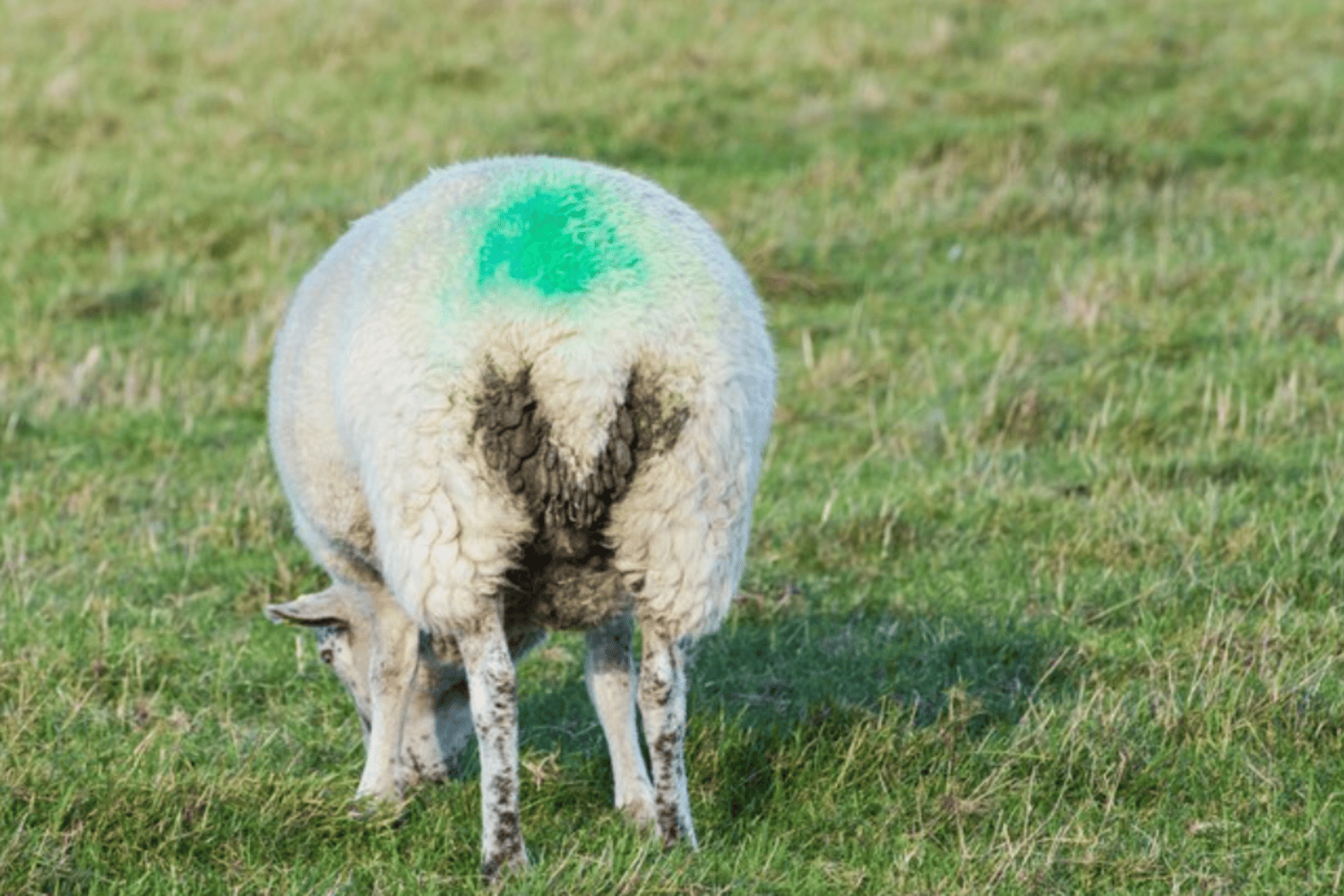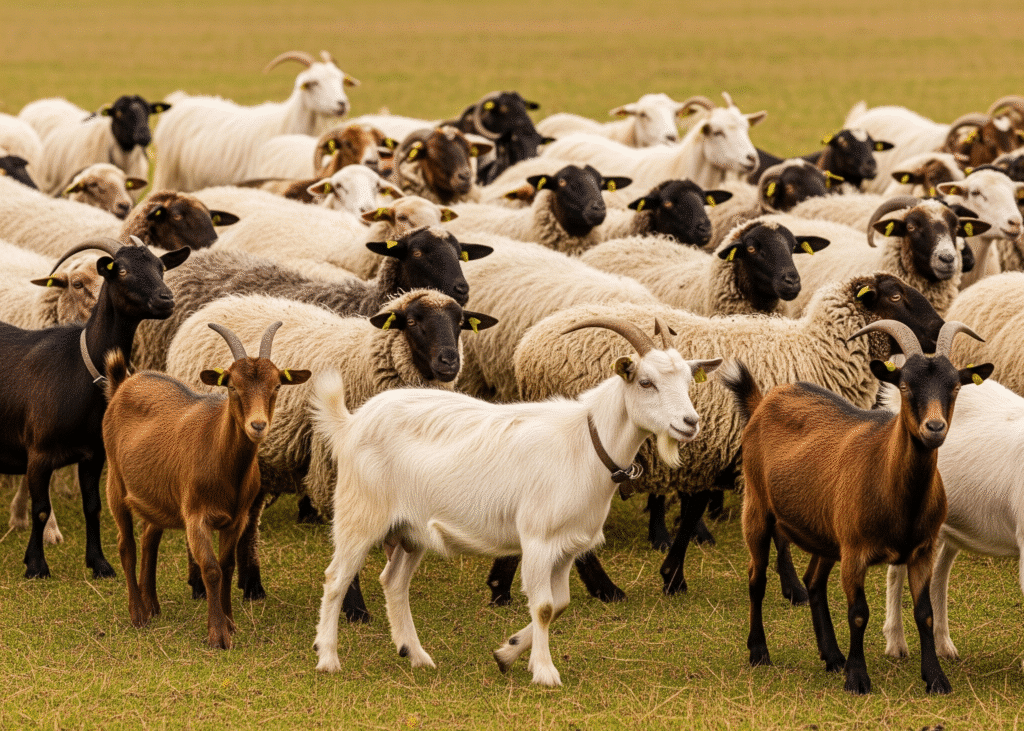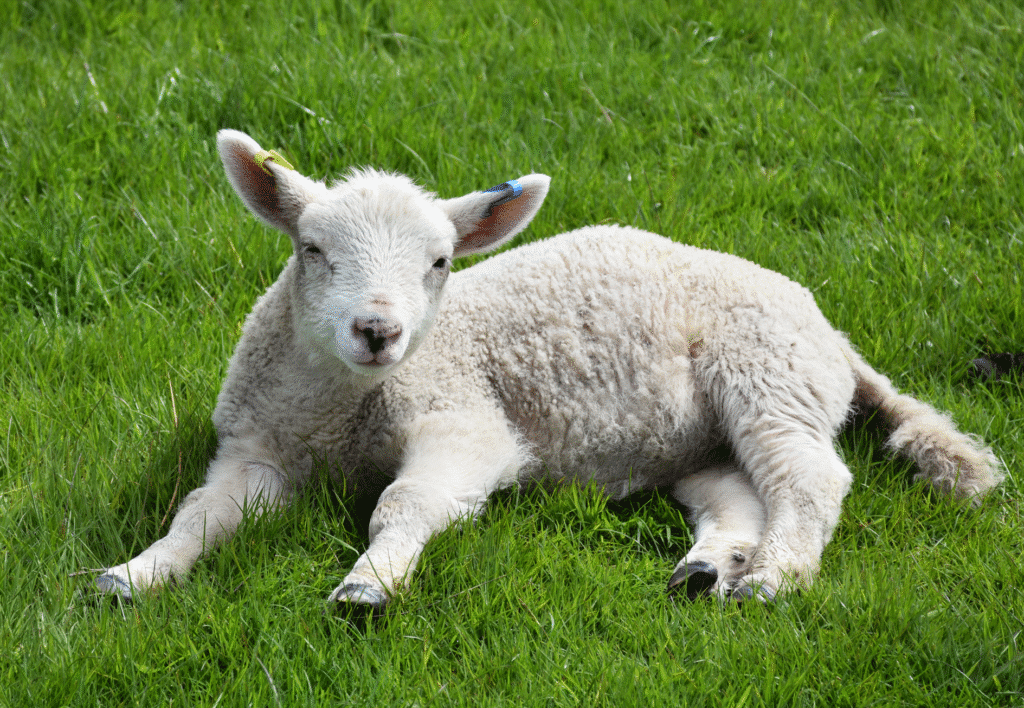Lamb Scours, or diarrhea, is a common Disease in young lambs, especially in the first few weeks of life. Scouring happens when a lamb passes loose or watery manure instead of normal droppings. Scouring is not a disease itself but a sign that something is wrong in the lamb’s gut and wants prompt treatment.
Many factors can cause scours in lambs at any age for various reasons. Bacteria, viruses, parasites, sudden changes in diet, or other health problems can cause it, such as sudden changes in milk, dirty feeding equipment, cold and wet weather, or infections from bacteria like E. coli, rotavirus, or cryptosporidium.
The most obvious symptom of scours is loose, watery, or very soft manure instead of normal small, firm pellets. Manure color can also indicate scours in lambs, such as green, black, or yellow scour in lamb. It looks like diarrhea in lambs. The area around the lamb’s tail may become stained or dirty. A lamb with scours may also look weak, tired, or stop drinking milk properly. You might notice it standing hunched, with a drooping head, or lying down more than normal.
Causes of scours in Lambs
Dieting is the main cause of lambs scouring. However, bacteria, viruses, E. coli, Clostridium perfringens, rotavirus, coronavirus, and several other factors can also cause scours in lambs and sheep.
Microbes (Bacteria and Viruses)
The gut of lambs naturally contains good bacteria, protozoa, and fungi that help with normal digestion. These friendly microbes usually keep harmful bacteria under control by competing for space and food. However, if a lamb’s immune system is weak, its gut balance is disturbed, or it is exposed to large amounts of harmful bacteria or viruses in the environment, these disease-causing microbes can take over and cause scours.
E. coli in Lambs
There are different types of E. coli that can cause scours in lambs.
Enterotoxigenic E. coli
Enterotoxigenic E. coli sticks to the gut lining (called villi) and multiplies by attaching to the cells (enterocytes). It releases toxins that make these cells push extra electrolytes into the gut, making the gut contents hypertonic. As a result, water is pulled in, causing very watery diarrhea. In this type, the gut cells are not damaged, so there is no inflammation, but lambs lose a lot of fluids and salts, which can quickly lead to dangerous dehydration. A lamb with this infection usually has a gut that looks normal on the inside, but is swollen with lots of fluid.
Enteropathogenic E. coli
Enteropathogenic E. coli also attaches to the gut lining, but it goes further by damaging the gut cells and destroying the tiny finger-like microvilli. This reduces the lamb’s ability to absorb nutrients and disrupts normal gut function. Damaged gut cells can let bacteria cross into the bloodstream, which may cause blood poisoning (sepsis). The gut lining becomes inflamed and swollen, making scours even worse. Because nutrients aren’t absorbed properly, lambs can lose weight and suffer from low blood sugar, especially young lambs. Severe infections can damage the gut so badly that they cause ulcers and bleeding, leading to scours with blood and mucus. If the damage happens high up in the gut, the manure may turn black because the blood is digested. If the damage is closer to the back end (colon or rectum), you may see fresh red blood in the manure.
Clostridium perfringens:
Clostridium perfringens Type C releases a toxin that causes intestinal bleeding (hemorrhagic enterotoxemia). Often, lambs are found dead without warning. If seen while still alive, affected lambs may show belly pain, bloody diarrhea, weakness, and depression. Other types of Clostridium can also cause diarrhea (scours), especially in bottle-fed lambs. Keeping lambs up to date with their CDT vaccines is important to prevent this.
Rotavirus & Coronavirus:
Both viruses infect the cells lining the intestines (enterocytes), damaging or killing them. This damage reduces the intestine’s ability to absorb nutrients. As a result, unabsorbed nutrients pull water into the gut, causing diarrhea. Because nutrients aren’t absorbed, lambs lose weight. Young lambs can also suffer from low blood sugar (hypoglycemia). The damaged cells can lead to diarrhea with blood and mucus. Infected lambs may have a fever and appear sick.
Other:
Other bacteria, such as Salmonella, Campylobacter, and Yersinia, as well as viruses, can also cause scours. Some types attach to and damage the gut lining, much like E. coli.
Bacterial and viral diarrhea is most common in young lambs (from birth to 2 weeks old). These lambs may be infected by more than one virus or bacteria at the same time. Scours are more likely when lambs don’t get enough colostrum or live in dirty environments where they may eat fecal material. Young animals often explore by chewing things, including dirty bedding. Ewes’ udders can also get contaminated with feces, exposing lambs during nursing. Milk or milk replacer is a good breeding ground for bacteria.
Older sheep can also develop scours, but it’s usually less severe. There’s often an underlying issue that weakens their resistance, such as:
- Mineral imbalances that weaken the immune system;
- Recent antibiotic use;
- Stress (e.g., poor nutrition, lambing, weaning, transport, parasites);
- High exposure to harmful bacteria from dirty water or food, overcrowding, or poor bedding.
Scour Treatment for Lambs
Lambs have limited body reserves and may have already faced a difficult start in life. Treating scours in lambs with mild effects usually takes less time and care to recover. However, severely affected lambs need a lot of attention and supportive care (TLC) and may still die despite your best efforts. If several lambs are showing signs of illness, it’s important to get your veterinarian involved as early as possible. A severe outbreak can result in major losses if not managed promptly.
Start with these basic steps for treating lamb scours
Rehydrate lamb immediately
Dehydration is the most serious and immediate threat to lambs with scours, as it can become fatal within a short period. In mild cases, administer oral electrolyte solutions containing glucose every few hours to help restore fluid balance and prevent hypoglycemia. However, if the lamb is too weak to drink or cannot stay hydrated, it will require intravenous or subcutaneous fluids, which must be administered by a veterinarian. To support recovery, always use warm fluids and provide them in small, frequent amounts rather than large volumes at once, as this is easier on the lamb’s digestive system.
Feeding Management
Feeding plays a vital role in lamb scour treatment. Avoid giving large quantities of milk or milk replacers in one sitting. Instead, provide small, frequent meals throughout the day. If you’re administering electrolyte solutions that contain glucose, it’s safe to skip a milk feeding temporarily. This helps reduce the digestive load and supports better absorption.
Keep Lambs Warm
Sick lambs struggle to regulate their body temperature, especially when dehydrated or weak. Keep them warm and dry to help conserve energy and support recovery. Cold stress can further suppress the immune system and slow down healing.
Boost Immunity with Serum
Administering a serum antibody product like Bovi-Sera can help stimulate the immune response in sick lambs. This can be especially helpful in lambs that may not have received sufficient colostrum or are dealing with multiple infections.
Antibiotic Use: Caution and Consideration
Antibiotics should be used with care. They are not effective against viruses and can destroy beneficial gut bacteria. Overuse also raises the risk of antibiotic resistance and may result in lambs becoming long-term carriers of harmful bacteria. That said, if the intestinal barrier is compromised and bacteria have entered the bloodstream, antibiotics become necessary to prevent or treat sepsis.
Severely ill lambs showing signs of systemic illness need antibiotic treatment. Mildly affected lambs that are eating well, behaving normally, and have a stable body temperature may not need antibiotics immediately—but monitor them closely. If they deteriorate, start treatment promptly. Work with your vet to choose an appropriate injectable antibiotic that targets gram-negative bacteria, achieves therapeutic blood levels, and is excreted into the bile to also reach the GI tract. Oral antibiotics may not be absorbed reliably in scouring lambs due to intestinal damage.
Use of Anti-Inflammatories
Anti-inflammatory medications can help reduce gut inflammation and improve comfort, but only use them after rehydration. Administering NSAIDs to a dehydrated lamb increases the risk of kidney damage. Use these medications cautiously, as they can also cause gastrointestinal ulcers if given too frequently. Always prioritize fluid therapy before considering anti-inflammatory drugs.
Prevention of Scouring in Lamb
Treating scours can be challenging, often requiring time and effort, and in some cases, it may lead to death if not handled quickly. That’s why prevention is always better than cure. By following a few simple steps ahead of time, you can greatly reduce the risk and keep your lambs healthy and thriving.
Keep Lambing Areas Spotlessly Clean and Dry
Why it matters: Pathogens that cause scours thrive in damp, dirty spaces.
What to do: Regularly remove soiled bedding, clean feeding bins, and disinfect water troughs. If possible, lamb outdoors in well-ventilated pens to reduce moisture and waste buildup. Keeping barns dry and tidy cuts the chance of infection early on.
Ensure Fast and Full Colostrum Intake
Why it matters: Colostrum delivers crucial antibodies during the first 12–24 hours.
What to do: Help each lamb drink its fill soon after birth. For smaller lambs or those with difficult teats, feed frozen colostrum, commercial substitutes, or use Bovi‑Sera/OVIShield for immunity support. Lack of early colostrum sharply raises scours risk.
Feed Ewes Well Pre-Lambing
Why it matters: A healthy mother means nutritious milk—and fewer pathogens.
What to do: Keep pregnant ewes in a balanced body condition. In late pregnancy, supply quality protein, minerals, and vitamins—products like DuraFerm® tubs can help. Well-fed ewes are less likely to shed bacteria in their waste.
Vaccinate Ewes to Protect Newborns
Why it matters: Vaccinations boost antibody levels in colostrum.
What to do: Administer CDT vaccines 2–4 weeks before lambing to prevent common bacterial scour pathogens. In high-risk flocks, vets may advise cattle scour vaccines off-label for extra protection.
Keep Lambs Grouped by Age
Why it matters: Older lambs can carry diseases without symptoms but infect younger ones.
What to do: House lambs in pens where age differences don’t exceed about 30 days. This lowers the risk of disease jumping from older, tolerant lambs to fragile newborns.
Immediately Isolate and Sanitize After a Case
Why it matters: Scouring lambs spread up to 48 hours after symptoms ease.
What to do: Separate sick lambs until they pass solid stool for 2–3 days. Bathe before returning them, then disinfect their pen to break the infection cycle.
Control Parasites Proactively
Why it matters: Parasites like coccidia and cryptosporidium are key scour causes.
What to do: Work with your vet to schedule deworming and anticoccidial treatments. Sanitation—clean bedding, fresh feed, and clean pens—helps prevent parasite buildup.
Support Lamb Gut Health
Why it matters: A healthy gut resists infections better.
What to do: Use supplements like Vita Charge® Clench Gel or probiotics to maintain gut flora and support digestion during stress.
Seek Veterinary Help for Ongoing Issues
Why it matters: Repeated scours suggest deeper health concerns.
What to do: If scour returns regularly—even with good hygiene and care—consult your vet. You may need diagnostic tests, customized vaccines, or targeted interventions.
Conclusion
Scours in lambs is a serious and potentially life-threatening condition, especially in the early weeks of life. While it is not a disease itself, it signals underlying health problems—ranging from dietary issues to infections caused by bacteria, viruses, or parasites. Early detection, proper treatment, and prompt veterinary support can improve outcomes, but prevention remains the most effective strategy.
Maintaining clean lambing environments, ensuring timely and adequate colostrum intake, vaccinating ewes, managing feeding practices, and supporting lamb immunity are all crucial steps in reducing the risk of scours. By staying proactive and vigilant, you can protect your lambs from unnecessary suffering, promote healthy growth, and reduce mortality rates in your flock.
Frequent asked questions about scoring in lambs
What is scouring in sheep/lambs?
Scouring, commonly known as diarrhea, is the passing of loose or watery feces. It is not a disease itself but a symptom of various underlying issues affecting the digestive system.
What is the meaning of scouring disease?
“Scouring disease” refers to diarrhea caused by infections (like E. coli, Clostridium, rotavirus), parasites (such as coccidia), or dietary problems. It often leads to dehydration, weight loss, weakness, and—if untreated—death, especially in lambs.
How to treat a sheep with Diarrhea?
To treat a sheep with diarrhea, first isolate it from the rest of the flock to prevent the spread of disease. Ensure it has access to plenty of clean water and consider giving electrolytes to prevent dehydration. Feed it plain hay and avoid rich or lush pasture that could worsen the condition. Finally, consult a veterinarian to check for parasites, infections, or other underlying causes and get appropriate treatment.
How to Treat Scours in Lambs or Diarrhea in Sheep:
The first and most critical step in treating scours is rehydration. Lambs suffering from diarrhea lose fluids rapidly and can become dangerously dehydrated. To counter this, administer oral electrolyte solutions containing glucose to help restore fluid balance and energy. In severe cases where lambs are too weak to drink, they may require subcutaneous or intravenous fluids, which should be given by a veterinarian.
Feeding must be managed carefully during recovery. Instead of giving large volumes of milk or milk replacer at once, offer small, frequent feedings throughout the day. If the lamb is receiving glucose-based electrolyte solutions, it’s safe to temporarily pause milk feeding to reduce stress on the digestive system.
Keeping the lambs warm and dry is essential, especially when they are weak. Cold and damp conditions can increase stress, suppress the immune system, and slow recovery. Proper bedding and shelter will help maintain body temperature and improve survival chances.
Antibiotics should only be used when absolutely necessary and always under veterinary supervision. If a bacterial infection is suspected—such as when fever, blood in the stool, or signs of systemic illness are present—appropriate antibiotic treatment may be needed. However, unnecessary use of antibiotics should be avoided, as it can disrupt healthy gut bacteria and contribute to resistance.
Anti-inflammatory drugs can also be helpful in reducing gut inflammation and improving comfort but should only be administered after rehydration. Giving these medications to a dehydrated lamb may cause kidney damage, so veterinary advice is crucial before their use.
It’s also important to isolate any lamb showing signs of scours to prevent the spread of infection. Sick animals should be kept apart from the healthy ones until their stool returns to normal for at least 2–3 days. The affected pen or area should be thoroughly cleaned and disinfected before reintroducing animals.
Finally, boosting immunity can support recovery, particularly in lambs that did not receive enough colostrum after birth. Administering antibody serums such as Bovi-Sera can help enhance the immune response and aid in overcoming infection.



